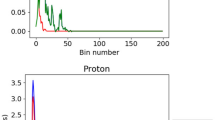Abstract
Understanding the nature of dark matter is a major challenge in modern Physics. During the last decades, several detectors have been built to detect the signal of interactions between dark matter and ordinary matter. DEAP-3600 is a liquid-argon detector with 3.3 tons of active volume placed at SNOLAB (Canada), 2.1 km underground. This detector aims at searching for weakly interacting massive particles (WIMP) as dark matter candidate. The interaction of WIMPs with a nucleus of argon is expected to produce scintillation light with a particular signature. In this work, a Multilayer Perceptron is used for separating this signature from other background signatures, and specifically from a frequent background originated in the neck of the detector. As a consequence of this work, an improvement in the classification of neck events is achieved, reaching a mean acceptance of 44.4% for a background rejection power of 99.9% of neck events for the same sample of simulated events.
Access this chapter
Tax calculation will be finalised at checkout
Purchases are for personal use only
Similar content being viewed by others
References
Agostinelli, S., et al.: Geant4 - a simulation toolkit. Nucl. Inst. Meth. A 506(3), 250–303 (2003). https://doi.org/10.1016/S0168-9002(03)01368-8
Bishop, C.M.: Neural Networks for Pattern Recognition. Oxford University Press Inc., New York (1995)
Cárdenas-Montes, M., Montes, B., Santorelli, R., Romero, L.: Evaluation of decision trees algorithms for position reconstruction in argon dark matter experiment. In: Martínez-Álvarez, F., Troncoso, A., Quintián, H., Corchado, E. (eds.) HAIS 2016. LNCS (LNAI), vol. 9648, pp. 575–587. Springer, Cham (2016). https://doi.org/10.1007/978-3-319-32034-2_48
Chollet, F., et al.: Keras (2015). https://github.com/fchollet/keras
DEAP-3600 Collaboration: DEAP-3600 dark matter search at SNOLAB. J. Phys.: Conf. Ser. 375(1), 012027 (2012). https://doi.org/10.1088/1742-6596/375/1/012027
DEAP-3600 Collaboration: Measurement of the scintillation time spectra and pulse-shape discrimination of low-energy \(\rm \beta \) and nuclear recoils in liquid argon with deap-1. Astropart. Phys. 85, 1–23 (2016). https://doi.org/10.1016/j.astropartphys.2016.09.002
DEAP-3600 Collaboration: Design and construction of the deap-3600 dark matter detector. Astropart. Phys. 108, 1–23 (2019). https://doi.org/10.1016/j.astropartphys.2018.09.006
DEAP-3600 Collaboration: Search for dark matter with a 231-day exposure of liquid argon using deap-3600 at snolab. Phys. Rev. D 100, 022004 (2019). https://doi.org/10.1103/PhysRevD.100.022004
Goodfellow, I., Bengio, Y., Courville, A.: Deep Learning. MIT Press, Cambridge (2016). http://www.deeplearningbook.org
Acknowledgment
The research leading to these results has received funding by the Spanish Ministry of Economy and Competitiveness (MINECO) for funding support through the grants FPA2017-82647-P and “Unidad de Excelencia María de Maeztu”: CIEMAT - FÍSICA DE PARTÍCULAS through the grant MDM-2015-0509.
We thank the Natural Sciences and Engineering Research Council of Canada, the Canadian Foundation for Innovation (CFI), the Ontario Ministry of Research and Innovation (MRI), and Alberta Advanced Education and Technology (ASRIP), Queen’s University, the University of Alberta, Carleton University, the Canada First Research Excellence Fund, the Arthur B. McDonald Canadian Astroparticle Research Institute, DGAPA-UNAM (PAPIIT No. IA100118) and Consejo Nacional de Ciencia y Tecnología (CONACyT, Mexico, Grants No. 252167 and A1-S-8960), the European Research Council Project (ERC StG 279980), the UK Science and Technology Facilities Council (STFC ST/K002570/1 and ST/R002908/1), the Russian Science Foundation (Grant No 16-12-10369), the Leverhulme Trust (ECF-20130496) and the International Research Agenda Programme AstroCeNT (MAB/2018/7) funded by the Foundation for Polish Science (FNP) from the European Regional Development Fund. Studentship support from the Rutherford Appleton Laboratory Particle Physics Division, STFC and SEPNet PhD is acknowledged. We would like to thank SNOLAB and its staff for support through underground space, logistical, and technical services. SNOLAB operations are supported by the CFI and Province of Ontario MRI, with underground access provided by Vale at the Creighton mine site. We thank Vale for support in shipping the acrylic vessel underground. We gratefully acknowledge the support of Compute Canada, Calcul Québec, the Center for Advanced Computing at Queen’s University, and the Computation Center for Particle and Astrophysics (C2PAP) at the Leibniz Supercomputer Center (LRZ) for providing the computing resources required to undertake this work.
Author information
Authors and Affiliations
Consortia
Corresponding author
Editor information
Editors and Affiliations
Rights and permissions
Copyright information
© 2020 Springer Nature Switzerland AG
About this paper
Cite this paper
Rodríguez-García, I., Pesudo, V., Santorelli, R., Cárdenas-Montes, M., on behalf of the DEAP-3600 Collaboration. (2020). Neural Networks for Background Rejection in DEAP-3600 Detector. In: de la Cal, E.A., Villar Flecha, J.R., Quintián, H., Corchado, E. (eds) Hybrid Artificial Intelligent Systems. HAIS 2020. Lecture Notes in Computer Science(), vol 12344. Springer, Cham. https://doi.org/10.1007/978-3-030-61705-9_53
Download citation
DOI: https://doi.org/10.1007/978-3-030-61705-9_53
Published:
Publisher Name: Springer, Cham
Print ISBN: 978-3-030-61704-2
Online ISBN: 978-3-030-61705-9
eBook Packages: Computer ScienceComputer Science (R0)




